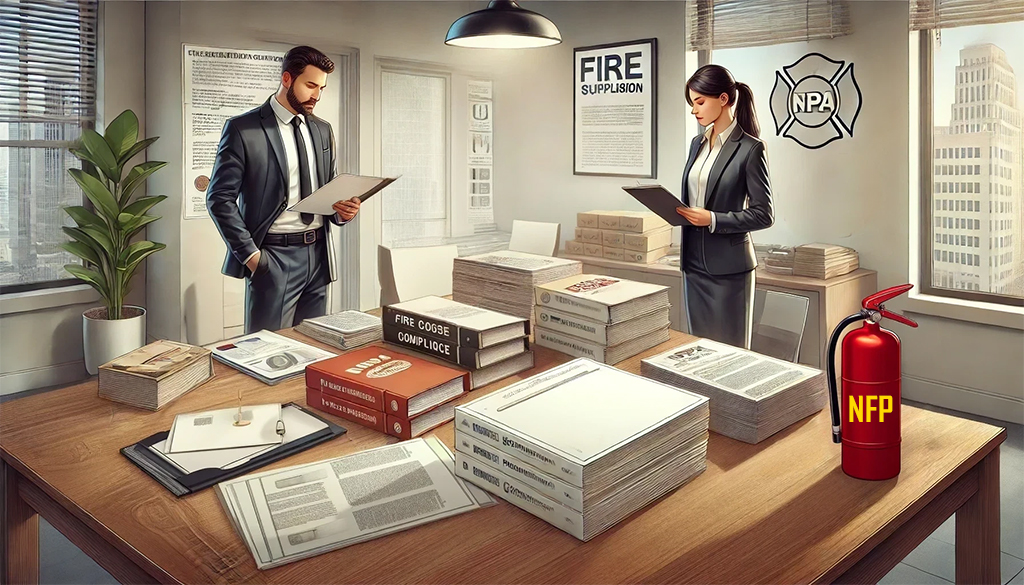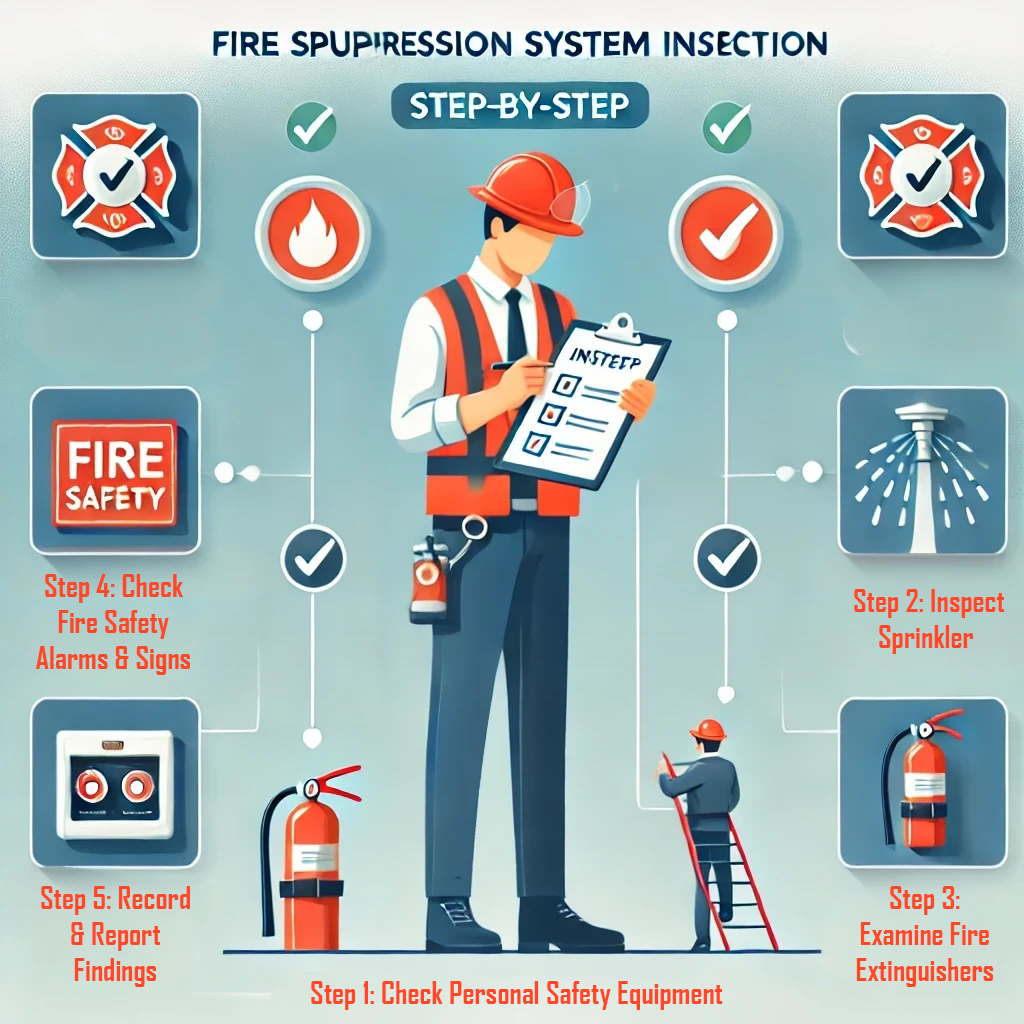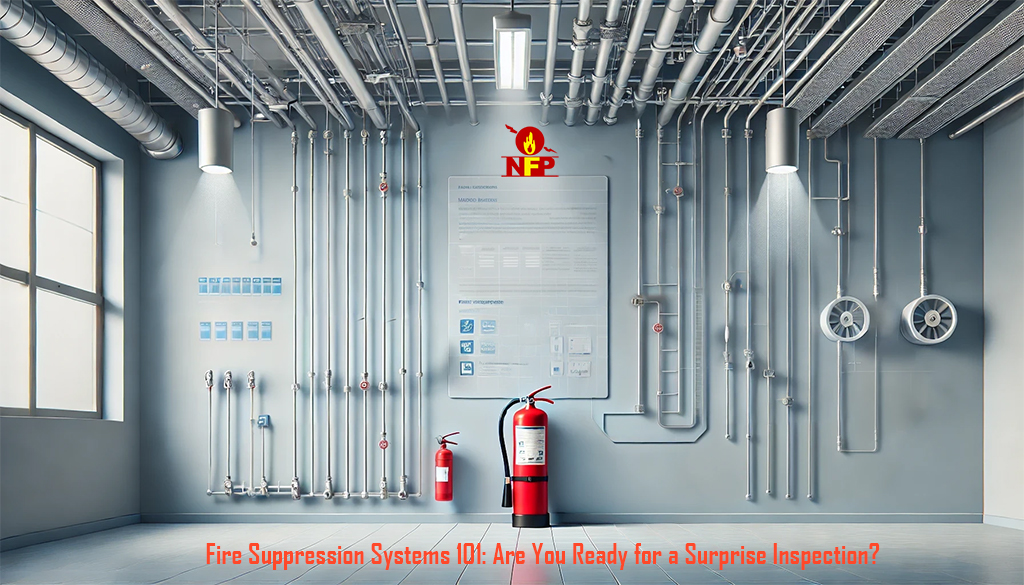Your fire suppression system inspection is the cornerstone of safeguarding your property and employees against unexpected fire hazards. In places like Orange County, where strict regulations and routine fire code checks are common, failing to maintain your equipment can lead to critical malfunctions—and potentially steep fines or safety risks.
In this comprehensive blog, we’ll cover everything you need to know about fire suppression system inspections: from simple checks you can perform on your own to preparing for a professional review. You’ll also learn how to stay one step ahead of unannounced inspections by following best practices for system upkeep and documentation.
Ready to pass your next inspection with confidence? Call Now and let our certified technicians at Nationwide Fire Protection ensure your system is compliant, fully operational, and ready to protect your business at a moment’s notice. Stay safe, avoid penalties, and keep your operations running smoothly—starting today!
Fire Suppression System Inspection Procedures
Keeping your fire suppression system in top shape is a critical responsibility for any property owner or manager. Not only does it protect your business from potential fire damage, but it also helps you remain compliant with local and national fire codes—particularly in areas like Orange County, where routine inspections are common. Below is a guide to developing a thorough inspection regimen, complete with recommended frequencies and essential checkpoints.
Organizing Your Inspections
- Maintain a Checklist: A comprehensive fire suppression system inspection checklist ensures you cover all components.
- Keep Equipment Manuals Handy: Having the original manuals on-site helps you quickly reference system specifications and troubleshooting steps.
- Record Everything: Always document inspection dates, noted issues, and any corrective actions taken. Proper records streamline future maintenance and demonstrate compliance.
Fire Suppression System Inspection Frequency
Weekly Inspections
- DIY Spot Checks: At least once a week, walk around your facility and look for signs of visible damage—such as corrosion, loose connections, or missing parts.
- Immediate Repairs: If you spot an issue (like a loose nozzle cap or rust on a valve), address it right away. Small fixes can prevent larger, costlier problems later.
Monthly Inspections
- Extinguisher Placement: Confirm that fire extinguishers are in their designated spots, accessible, and have intact maintenance tags.
- Pressure Gauges & Nozzle Caps: Look for leaks or low pressure on gauges, and ensure nozzle caps are free of cracks or blockages.
- Obstruction Removal: Clear away any items that might obstruct the proper functioning of the suppression system.
Quarterly Inspections
- Water Flow & Valves: Every three months, test the water flow to sprinkler systems and confirm that valves function correctly.
- Hydraulic Nameplates: Verify that all nameplates are in place and legible—this documentation is crucial for NFPA 25 compliance and future inspections.
- Component Integrity: Check hoses, pipes, and fittings for wear or damage that could compromise performance.
Annual Inspections
- Professional Assessment: A certified technician should conduct a full fire suppression system inspection each year.
- Comprehensive Testing: Experts will test detection devices, control panels, sprinkler heads, and more to ensure full operational readiness.
- Repair & Maintenance: Any damaged pipes, fittings, or electronic components should be repaired or replaced immediately to maintain compliance and safety.
By following these inspection frequencies and maintaining a detailed checklist, you’ll significantly reduce the risk of sudden malfunctions—and you’ll be more than ready for surprise inspections. For expert guidance or professional annual checkups, Call (310) 750-9999 and let our certified team keep your fire suppression system at peak performance.
Steps to Pass a Fire Suppression System Inspection

Once you’re familiar with fire suppression system testing and maintenance procedures, it’s time to prepare for an official inspection. By following the steps below, you can help ensure your facility meets every requirement—and avoid the costly penalties that can come from non-compliance.
- Organize Your Documentation
- Keep detailed records of all maintenance activities, inspection dates, and system upgrades.
- Ensure that each fire suppression component has an updated tag or label indicating the last inspection.
- Maintain copies of system manuals and any relevant service reports in a central, easily accessible location.
- Conduct Routine Self-Assessments
- Perform weekly and monthly checks to catch obvious signs of wear, corrosion, or malfunction.
- Regularly train staff to identify red flags and promptly report any issues.
- Address minor repairs immediately to avoid escalation into more significant—and more expensive—problems.
- Schedule Professional Tune-Ups
- Beyond DIY inspections, arrange for certified technicians to perform thorough quarterly and annual assessments.
- Comprehensive checkups can reveal hidden issues like pipe blockages or malfunctioning detection components.
- Proactive maintenance not only ensures safety but can also save you money by preventing costly emergencies.
- Stay Informed About Local Regulations
- Different jurisdictions may have specific rules regarding testing, documentation, and equipment standards.
- Consult with local fire authorities in Orange County or review city ordinances to confirm you’re compliant with all requirements.
NFPA 25 is the go-to resource for anyone managing or maintaining a fire sprinkler system. These guidelines set the standard for inspecting, testing, and maintaining water-based fire protection systems, ensuring optimal performance and compliance. As a business owner or manager, staying familiar with the latest NFPA 25 requirements is essential for:
- Accurate Testing Intervals: Align your inspection schedule (weekly, monthly, quarterly, and annual) with NFPA 25 recommendations.
- Proper Documentation: Keep thorough records of each maintenance check and repair to demonstrate compliance during surprise inspections.
- Employee Safety: Ensure your employees know how to react in a fire emergency and understand the basic functions of your suppression system.
By following these guidelines and routinely verifying your system’s integrity, you’ll be well-prepared for any fire suppression system inspection—whether it’s scheduled or a surprise. If you need professional assistance or want to guarantee your system meets every legal requirement, Call (310) 750-9999 and let our team of experts help protect your investment.
Fire Suppression System Compliance Standards

Ensuring your fire suppression system meets both national and local standards is essential for maintaining a safe work environment and avoiding costly penalties. Here’s an overview of the key compliance areas you should consider:
National and Local Regulations
- Governing Bodies: Organizations like the National Fire Protection Association (NFPA) and the International Organization for Standardization (ISO) set broad guidelines.
- Local Enforcement: In many regions, including Orange County, fire departments or other local authorities have the power to adopt and enforce these standards in ways that address specific local risks.
System Design and Installation
- Compliance from the Start: Proper design and installation are critical for effective fire suppression. This involves selecting the right agent type (e.g., water, foam, or chemical), ensuring correct system capacity, and incorporating reliable detection methods.
- Activation Mechanisms: Make sure your system can activate quickly under the right conditions. Sensing devices, triggers, and control panels must be installed in accordance with professional guidelines to guarantee optimal performance.
Inspection and Maintenance
- Frequent Assessments: Regular fire suppression system inspection and maintenance are crucial for spotting issues early—before they escalate into serious hazards or code violations.
- Regulatory Requirements: NFPA 25 and local mandates often dictate how often you need to test equipment, including weekly, monthly, quarterly, and annual checks. Staying on schedule helps you maintain continuous compliance.
Recordkeeping and Documentation
- Organized Records: Document every inspection, repair, and test result. This historical data not only proves compliance but also aids in troubleshooting.
- Easy Accessibility: Keep logs and maintenance certificates in a central location so inspectors and authorized personnel can review them quickly.
Training and Certification
- Qualified Personnel: Anyone who designs, installs, inspects, or maintains your fire suppression system must have the proper certifications.
- Regular Updates: As standards evolve, ensure that your team’s certifications and knowledge remain current. Ongoing training helps uphold best practices and regulatory compliance.
By following these standards and keeping up with routine inspections, you’ll protect your business, employees, and customers from potential fire-related incidents—and stay one step ahead of local fire code requirements. To schedule a professional inspection or discuss compliance solutions tailored to your facility, Call (310) 750-9999 and let our certified team ensure your system meets all necessary regulations.
Fire Suppression System Inspection Training
Even the most basic knowledge of fire suppression system inspection can transform your weekly and monthly checks into invaluable safeguards for your business. By understanding key inspection points—such as pressure levels, equipment placement, and signs of corrosion—you can detect small issues before they escalate into major hazards.
- Online Courses and Certifications: Institutions like Fire Tech offer comprehensive e-learning options covering fundamental inspection and maintenance practices. This includes how to read gauges, assess extinguisher readiness, and identify obstructions.
- Staff Awareness: Training your staff to recognize early warning signs greatly reduces downtime and potential damage. Whether it’s a blocked sprinkler head or a malfunctioning alarm, well-informed employees can address or report problems immediately.
- Compliance Benefits: Properly trained personnel help maintain compliance with both NFPA 25 guidelines and local fire codes in areas like Orange County, ensuring you’re always ready for an unannounced inspection.
Common Fire Suppression System Inspection Violations
Even small oversights can lead to significant code violations. Below are some of the most frequent issues found during official inspections:
- Blocked Doors: Emergency exits must be clear at all times for safe evacuation.
- Malfunctioning Emergency Exit Lighting: Inadequate lighting can cause confusion during an evacuation.
- Improper Fire Extinguishers: Units must be the correct type, properly charged, and easily accessible.
- Overloaded Electrical Outlets: Too many cords in a single outlet can spark a fire hazard.
- Faulty Extension Cords: Damaged cords or inappropriate usage can lead to short circuits.
- Blocked Fire Sprinklers: Keep furniture, storage, or decorations away from sprinkler heads.
- Malfunctioning Fire Alarms: Alarms should be tested regularly to ensure they’re fully operational.
- Improper Storage of Flammable Materials: Store chemicals, fuels, and other flammables in designated, well-ventilated areas.
Don’t put your business at risk for fines, shutdowns, or safety hazards. Call (310) 750-9999 and let our certified professionals at Nationwide Fire Protection help you stay compliant, safe, and ready for any inspection.
FAQs About Fire Suppression System Inspection
How Often Should I Inspect My Fire Suppression System?
Regular self-inspections—weekly or monthly—are crucial for spotting visible damage, pressure issues, or misplaced equipment. In addition, quarterly and annual inspections by certified technicians are essential to ensure full functionality and compliance with both NFPA guidelines and local regulations in Orange County.
What Happens During a Fire Suppression System Inspection?
Professional inspectors examine every component of your system, including alarms, control valves, piping, detection tubing, triggers, and sprinkler heads. They look for physical damage, obstructions, and any signs of malfunction to verify that everything functions properly and meets fire code requirements.
Who Can Perform a Fire Suppression System Inspection?
Only properly trained and certified individuals or companies are qualified to conduct these inspections. Local authorities often require proof of certification or specialized training, particularly in regions with stringent fire safety regulations such as Orange County.
Does My Fire Suppression System Need to Be Inspected Annually?
Yes. Many fire codes mandate annual inspections at a minimum. However, certain system components may require monthly or quarterly check-ups, depending on local regulations and the specific type of suppression system you have in place.
What Documents Are Needed for a Fire Suppression System Inspection?
It’s vital to keep maintenance tags or certificates attached to your system, showing dates of previous inspections and any repairs performed. Maintaining a record of all past services, tests, and maintenance activities provides a clear history, which can be invaluable for troubleshooting and compliance checks.
Ensure Your Fire Suppression System Is Inspection-Ready
Your safety is our top priority. At Nationwide Fire Protection, we specialize in making fire suppression system inspections straightforward and reliable, ensuring both regulatory compliance and peace of mind. If you’re located in Orange County and need expert guidance or inspection services:
Call (310) 750-9999 today! Let’s work together to keep your system ready for any surprise inspection and safeguard your business from fire hazards.

